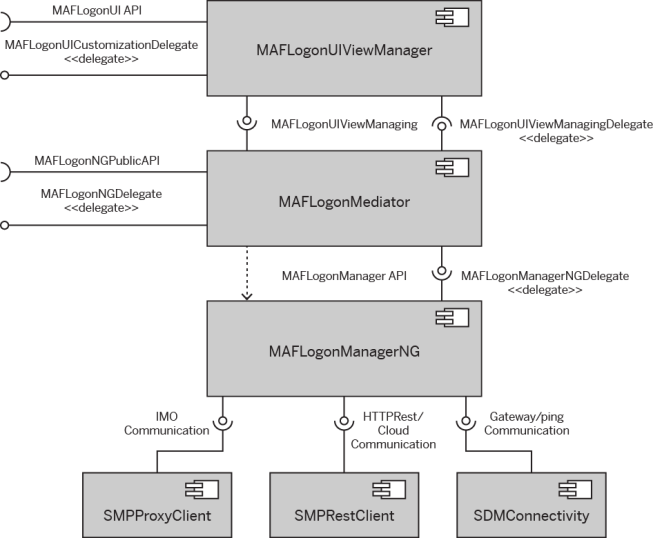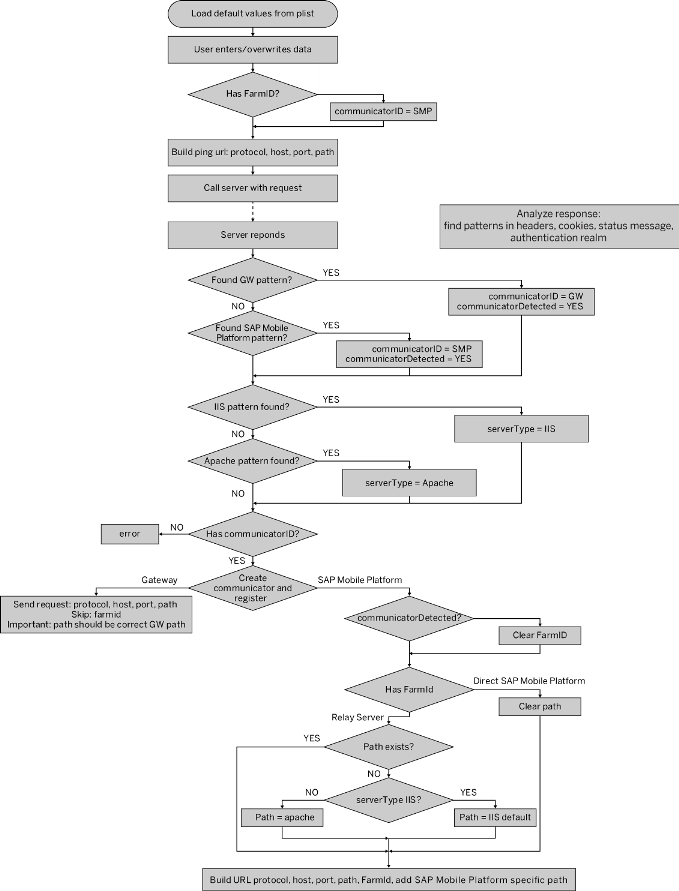To change the behavior of MAFLogonManagerNG, adjust the feature and default values configuration files at build time. The plist format configuration files are located in the MAFLogonManagerNG.bundle folder. plist is an XML format that can be adjusted in Xcode or in any text editor.
Feature Configuration
To change the behavior of the component, adjust the MAFLogonManagerOptions.plist file, which is in the MAFLogonManagerNG bundle folder in your project.
| Key | Value Type | Description | Default Value |
|---|---|---|---|
| keyMAFUrlSchemeForAfaria | String | Changes the default URL Scheme of the Afaria application. | EMPTY |
| keyMAFUseAfaria | BOOL |
Determines whether to use Afaria. NO - the Afaria client application is not called, even if it is present on the iOS device YES - Afaria client application is always called. |
YES |
You can also declare resources with the MAFLogonUIOptions.plist feature configuration, which is in the MAFLogonUING bundle.
| Key | Value Type | Description | Default Value |
|---|---|---|---|
| keyMAFLogonUseFlowMode | BOOL | YES - Logon Core tries to find a suitable communicator implementation for the infrastructure used. It analyses the input provided by the user and triggers test requests to test the various onboarding scenarios. | YES |
| keyMAFLogonAllowAutomaticSecureStoreCreation | BOOL | Whether to allow the creation of the secure store automatically.
NO - the secure store should be provided/created before the logon component is initialized. |
YES |
| keyMAFLogonUseSplashScreen | BOOL | Determines whether to present splash screen when logon operation is called for the first time. | YES |
| keyMAFLogonOperationContextHideRegistrationFields | BOOL | Defines which fields to show on the resgistratoin screen. | Multiple values |
Default Values Configuration
| Key | Value Type | Description | Default Value |
|---|---|---|---|
| keyMAFLogonOperationContextServerPortNonSecure | Number | Non secure port | 8000 |
| keyMAFLogonOperationContextServerPortSecure | Number | Secure port | 443 |
| keyMAFLogonOperationContextServerHost | String | Server host name without protocol or port or suffixes | EMPTY |
| keyMAFLogonOperationContextServerPort | Number | Server port | EMPTY |
| keyMAFLogonOperationContextIsHttps | BOOL | Whether to use secure channel | YES |
| keyMAFLogonOperationContextServerDomain | String | The default domain to use. Only used when an SAP Mobile Platform server is present. The domain separation should be supported by the used SAP Mobile Platform server. | default |
| keyMAFLogonOperationContextFarmId | String | The default farm ID name to be used if a Relay server is included. | EMPTY |
| keyMAFLogonOperationContextSecurityConfig | String | The default security configuration name to use. | EMPTY |
| keyMAFLogonOperationContextGatewayClient | String | The default sap-client to be used when communicating with the GW. | EMPTY |
| keyMAFLogonOperationContextGatewayPingPath | String | The default GW ping path to be used. | sap/bc/ping |
| keyMAFLogonOperationContextResourcePath | String | The default path to be used for routing through the reverse proxy if any exists | EMPTY |
| keyMAFLogonOperationContextBackendUserName | String | The default GW username to be used | EMPTY |
| keyMAFLogonOperationContextPasswordPolicy | Dictionary | The default password policy to apply if no server side policy was provided. | Default password policy |
//replace this with your way of accessing MAFLogonUIViewManager->NSObject<MAFLogonNGPublicAPI> (the logon manager public API) NSMutableDictionary* defaultValues = [logonUIViewManager.logonManager defaultValues]; NSMutableDictionary* contextDefaultValues = [defaultValues objectForKey:@"keyMAFLogonOperationContextDefaultValues"]; NSMutableDictionary* registerContextType = [contextDefaultValues objectForKey:@"idMAFLogonOperationContextTypeRegister"]; [registerContextType setObject:@"300" forKey:@" keyMAFLogonOperationContextGatewayClient"]; [defaultValues setObject:contextDefaultValues forKey:@"keyMAFLogonOperationContextDefaultValues"];
Integrating Directly with Logon Manager
MAFLogonManagerNG is an Objective-C library that you can integrate with any UI implementation. MAF includes a default native Logon UI, but you can also build your own UI.
This image shows a possible architecture of an application integrating directly with MAFLogonManagerNG without using MAFLogonUING:

#import <UIKit/UIKit.h> @protocol MAFLogonNGPublicAPI; @protocol MAFLogonUICustomizationDelegate; /** This class handles the navigation between the screens */ @interface MAFLogonUIViewManager : NSObject <MAFLogonUIViewManaging, MAFLogonUIViewManagingDelegate> /** The logonMediator where the operations can be initiated. One has to set up the @see logonDelegate to be notified about the result of the operations */ @property (readonly) NSObject<MAFLogonNGPublicAPI> *logonMediator; /** The actually presented viewController of the application. This will be used to present the logon related screens. */ @property (nonatomic, retain) UIViewController* parentViewController;
- (id)init {
self = [super init];
if (self) {
self.logonMediator = [[MAFLogonMediator alloc] init];
self.logonMediator.logonUIViewManager = self;
}
return self;
}
To execute a logon operation, call:
- (IBAction)logonButtonTapped:(id)sender {
[logonUIViewManager.logonManager logon];
}
#pragma mark - MAFLogonUIViewManaging methods
-(void) showViewWithUIContext:(NSMutableDictionary *)aUIContext{
if([[NSThread currentThread] isMainThread]){
[self doShowViewWithUIContext:aUIContext];
}
else{
dispatch_sync(dispatch_get_main_queue(), ^{
[self doShowViewWithUIContext:aUIContext]; //do your custom UI building here!
});
}
}
- (void) operationRespondsWithOperationContext:(NSMutableDictionary *)anOperationContext error:(NSError *)anError {
[currentViewManager operationRespondsWithOperationContext:anOperationContext error:anError];
}
-(void) closeUI {
[currentViewManager release];
currentViewManager = nil;
currentOperationContextType = @"";
[[self baseViewController] popToRootViewControllerAnimated:NO];
[self.parentViewController dismissViewControllerAnimated:YES completion:^(void){
}];
}
#pragma mark - MAFLogonUIViewManaging
- (void) operationRespondsWithOperationContext:(NSMutableDictionary *)anOperationContext error:(NSError *)anError {
[self hideActivityIndicator];
if (anError != nil && anError.code!=0) {
[self presentError:anError];
}
}
Supported Onboarding Scenarios
The MAFLogonManagerNG supports multiple onboarding scenarios, based on the most common infrastructure setups supported by enterprise mobile applications. The company IT of the customer can have SAP Mobile Platform installed and use relay server to route Internet requests to intranet-hosted Gateway systems. Another possibility is to have SAP Mobile Platform, but replace the relay server with IIS or Apache and use it as a reverse proxy.
Logon Method Selection
MAFLogonManagerNG determines the target infrastructure, which can be SAP Mobile Platform or Gateway. It uses this logic:

The operation context object, which contains all information entered by the end user, passes the information to MAFLogonManagerNG. Based on the information, MAFLogonManagerNG decides whether the device user wants to use SAP Mobile Platform server. If the user provides a farm ID , the logon manager constructs and sends an SAP Mobile Platform server communicator-based test request.
- Direct Gateway
- Direct SAP Mobile Platform server
- SAP Mobile Platform server with relay server
- SAP Mobile Platform server with third-party reverse proxy
Additionally, MAFLogonManagerNG searches for any information in the context and selects a method based on all of this information. The context can have default values that are configured by the application developer.
Success and Failure Handling
Onboarding consists of two steps. The first is registration, where MAFLogonManagerNG uses input from the device user to contact the server and register. If this step is successful, your application can send requests to the GW server and obtain data. The second step is to create a data vault on the user device, in which to securely store user credentials and other sensitive information. The data vault must be secured with a passcode and satisfy the requirements of the password policy.
#define kErrorDomainLogonManager @"MAFLogonManagerNGErrorDomain" #define errMAFLogonManagerErrorOperationCancelled 0 #define errMAFLogonManagerErrorInvalidParameter 1 #define errMAFLogonManagerErrorInvalidOperationCode 2 #define errMAFLogonManagerErrorCommunicationManagerError 3 #define errMAFLogonManagerErrorUserAlreadyLoggedIn 4 #define errMAFLogonManagerErrorOperationExecutionInProgress 5 #define errMAFLogonManagerErrorInvalidOperationContext 6 #define errMAFLogonManagerErrorInvalidCommunicatorId 7 #define errMAFLogonManagerErrorInvalidActionItemId 8 #define errMAFLogonManagerErrorCouldNotDecideCommunicator 9 #define errMAFLogonManagerErrorPasswordsNotEqual 10 #define errMAFLogonManagerErrorOperationNotAllowed 11 #define errMAFLogonManagerErrorInvalidServerHost 12 #define errMAFLogonManagerErrorInvalidBackendPassword 13 #define errMAFLogonManagerErrorPasscodeChangeNotEnabled 14 #define errMAFLogonManagerErrorUploadTraceFailed 15